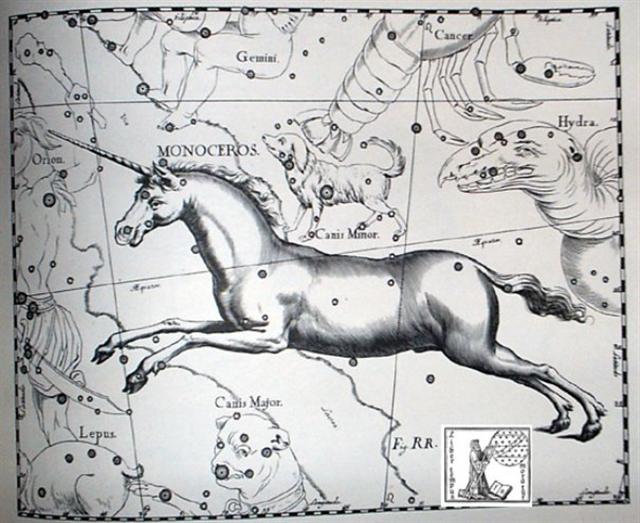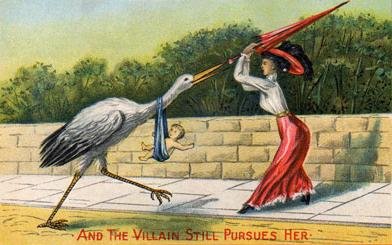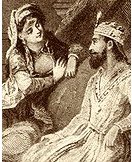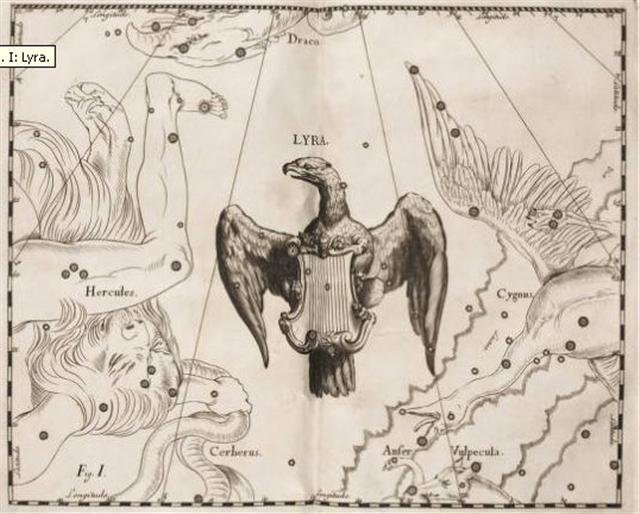48. The Bow (Kaus) of the Archer was illustrated by Hevelius as 'crooked', i.e. as not straight - and in stark contrast to his picture of the very straight horn of Monoceros half a year away:   
However, the vane on the Archer's bow was very straight and with its point (γ) placed in the river named the Milky Way. The English have a custom of mixing their tea with milk, and somewhere far away there was a 'land of milk (cfr malik, king) and honey (→ the queen herself)'.
... His temple-palace was composed of four radiant apartments: one toward the east, yellow with gold; one towards the west, blue with turquoise and jade; one toward the south, white with pearls and shells; one towards the north, red with bloodstones - symbolizing the cardinal quarters of the world over which the light of the sun holds sway. And it was set wonderfully above a mighty river that passed through the midst of the city of Tula; so that every night, precisely at midnight, the king descended into the river to bathe; and the place of his bath was called 'In the Painted Vase', or 'In the Precious Waters' ... ... In China, with Capricornus, Pisces, and a part of Sagittarius, it [Aquarius] constituted the early Serpent, or Turtle, Tien Yuen; and later was known as Hiuen Ying, the Dark Warrior and Hero, or Darkly Flourishing One, the Hiuen Wu, or Hiuen Heaou, of the Han dynasty, which Dupuis gave as Hiven Mao. It was a symbol of the emperor Tchoun Hin, in whose reign was a great deluge; but after the Jesuits came in it became Paou Ping, the Precious Vase. It contained three of the sieu, and headed the list of zodiac signs as the Rat, which in the far East was the ideograph for 'water', and still so remains in the almanacs of Central Asia, Cochin China, and Japan ...
And 10 days after λ Sagittarii / β Monocerotis will be found δ Monocerotis / τ Sagittarii (marking the last of the 8 stars in the prominent asterism of the Tea-pot, t-pot): ... 'Tell us a story!' said the March Hare. 'Yes, please do!' pleaded Alice. 'And be quick about it', added the Hatter, 'or you'll be asleep again before it's done.' 'Once upon a time there were three little sisters', the Dormouse began in a great hurry: 'and their names were Elsie [ε], Lacie [λ], and Tillie [τ]; and they lived at the bottom of a well — ' 'What did they live on?' said Alice, who always took a great interest in questions of eating and drinking. 'They lived on treacle,' said the Dormouse, after thinking a minute or two. 'They couldn't have done that, you know', Alice gently remarked. 'They'd have been ill.' 'So they were', said the Dormouse; 'very ill'. Alice tried a little to fancy herself what such an extraordinary way of living would be like, but it puzzled her too much: so she went on : 'But why did they live at the bottom of a well?' 'Take some more tea [= t as in duration of time]', the March Hare said to Alice, very earnestly. 'I've had nothing yet', Alice replied in an offended tone: 'so I can't take more [<]'. 'You mean you can't take less [>]', said the Hatter: 'it's very easy to take more than nothing'. 'Nobody asked your opinion', said Alice. 'Who's making personal remarks now?' the Hatter remarked triumphantly. Alice did not quite know what to say to this: so she helped herself to some tea and bread-and-butter, and then turned to the Dormouse, and repeated her question. 'Why did they live at the bottom of a well?' The Dormouse again took a minute or two to think about it, and then said 'It was a treacle-well.' 'There's no such thing!' Alice was beginning very angrily, but the Hatter and the March Hare went 'Sh! Sh!' and the Dormouse sulkily remarked 'If you ca'n't be civil, you'd better finish the story for yourself.' 'No, please go on!' Alice said very humbly. 'I wo'n't interrupt you again. I dare say there may be one.' 'One, indeed!' said the Dormouse indignantly. However, he consented to go on. 'And so these three little sisters - they were learning to draw, you know —' 'What did they draw?' said Alice, quite forgetting her promise. 'Treacle', said the Dormouse, without considering at all, this time. 'I wan't a clean cup', interrupted the Hatter: 'let's all move [hop] one place on.' He moved as he spoke, and the Dormouse followed him: the March Hare moved into the Dormouse's place, and Alice rather unwillingly took the place of the March Hare. The Hatter was the only one who got any advantage from the change; and Alice was a good deal worse off than before, as the March Hare had just upsed the milk-jug into his plate [creating the Milky Way river] ...
The creator of the G text has indicated a kind of inversion at glyph number 225. ... The Mahabharata insists on six as the number of the Pleiades as well as of the mothers of Skanda and gives a very broad and wild description of the birth and the installation of Kartikeya 'by the assembled gods ... as their generalissimo', which is shattering, somehow, driving home how little one understands as yet. The least which can be said, assuredly: Mars was 'installed' during a more or less close conjunction of all planets; in Mbh. 9.45 (p. 133) it is stressed that the powerful gods assembled 'all poured water upon Skanda, even as the gods had poured water on the head of Varuna, the lord of waters, for investing him with dominion'. And this 'investiture' took place at the beginning of the Krita Yuga, the Golden Age ... ... And in AUGUST 13 - day 225 according to the Golden Age of the Bull - would then arrive the Creation of Our Present World, as defined from Ursa Minor instead of Ursa Major ...
|
||||||||||||||||||||||||||||||||||||||||||||||||||||||||||||||||||||||||||||||||||||||||||||||||||||||||||||||||||||||||||||||||||||||||||||||||||||||||||||||||||||||||||||||||||||||||||||||||||||||||||||||||||||||||||||||||||||||||||||||||||||||||||||||||||||||||||||||||||||||

.jpg)














.jpg)







